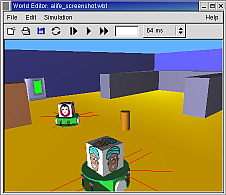ALife III
simulated robots looking for energy in a maze-like environment
Two robots are roaming a maze-like environment, looking for energy. Energy is provided by chargers. However, chargers are scattered all around the environment and it is not so easy for the robots to find them. Moreover, once used by a robot, a charger will be unavailable for a while. Hence, the robot will have to go away and look for another charger. A robot will die if it fails finding an available charger before it runs out of energy. Then, the remaining robot will be declared the winner of the match.

|
Alex — G-BAGS based controller
The heart of the controller is going to be a graph based map,
made according to the G-BAGS (Graph-Based Adaptive
Guiding System) described in more detail in Winkler's master theses.
For now only example source code for user control of the robot
is available along with some descriptions. Author Zbyněk Winkler.
|

|
Wolf — controller based on skills
Wolf is s simple controller based on skills. A skill is a simple behavior, that
can be easily debugged. The original intention was to have a
three-level-architecture, but currently it seems that two levels will be
sufficient. The source code is available for download. Author Martin Dlouhý.
|
Quick Info
 Screenshot |
The scoring is based on a hall of fame. Once a new controller is submited
to the web site, it is appended to the bottom. Every day one round is played.
If n robots are presents in the hall of fame, n-1 matches
will be played each round. The first match confronts the last robot (bottom
rank in the hall of fame) to the robot of rank #n-1. If the last robot
wins, the two robots swap their positions in the hall of fame.
Otherwise, nothing is changed. The next match confronts the robot ranked
#n-2 with robot ranked #n-1 and so on until we reach the top
of the hall of fame.
This way a robot can theoretically climp up from the bottom to the top position
within a single round. However, a robot can loose only one rank per round. This
is to encourage new competitors to submit their robots and have a chance
to climb up the hall of fame rapidly. A round is played every day during the contest.
It is always possible to introduce a new version of an existing robot
controller, by simply uploading the versions of the .class files, erasing any
previous ones. When a new version of a robot controller is introduced in the
contest, its position in the hall of fame remains unchanged. The next matches
are run using the new version.
You can find more information at the contest homepage.
The information presented here is adopted from the official
contest description.
If you have further questions you can use
webots-contest -at- yahoogroups.com list or you can
ask us (in czech or english) through our
feedback form.